Client
Introduction: The crude oil volatility was strong in November, and the mood fluctuations and inventory changes in the production restriction agreement caused the oil price to fluctuate greatly. From the perspective of supply and demand, from the perspective of global supply and demand, global crude oil production is still increasing. The negotiation of OPEC's limited production has caused market sentiment to fluctuate. Russia's attitude of reducing production has made oil price fluctuations sensitive. Can OPEC joint production limit reduce global crude oil supply? Can relying on production restrictions to push the price of oil prices up? This paper will analyze in detail the growth potential of crude oil production in the main producing countries of OPEC.
Recently, the topic of joint production restrictions around OPEC has been heated up. Oil prices have been twisted and twisted. Can OPEC joint production limit reduce global crude oil supply? Can relying on production restrictions to push the price of oil prices up? This paper will analyze in detail the growth potential of crude oil production in the main producing countries of OPEC.
Crude oil production capacity is a macro concept and the data is extremely unstable. Crude oil production capacity refers to the maximum production capacity of existing oil or oil fields in a given area under existing political and economic conditions. The size of crude oil production capacity can directly reflect the strength of current crude oil supply capacity. For the crude oil market, especially international oil prices, global crude oil surplus capacity is a more critical indicator, which will have a strong impact on medium and long-term international oil prices. .
The remaining capacity of crude oil can indicate the level of global crude oil supply capacity in the future. OPEC has a place in the global crude oil supply pattern. This paper attempts to explain the remaining capacity of OPEC crude oil through the oilfield production capacity of OPEC's major oil producing countries and the commissioning of future oilfield projects. Through data compilation, it has been found that OPEC crude oil production has not dropped significantly since the continuous increase in crude oil production. Instead, it will be greatly improved due to the expansion of the oilfield capacity of member countries, the existing oilfield production plan and the new oil tendering contract.
I. Factors affecting the remaining capacity
In recent years, both the IEA and the EIA, the release of OPEC crude oil surplus capacity data, all pointed to insufficient surplus capacity, which also caused investors to worry about future crude oil supply capacity. But we do not believe that the global crude oil surplus capacity is in short supply.
Crude oil surplus capacity is not a persistent and stable data, and many external conditions can have a direct impact on it. For example, different oil fields or oil wells are at different stages, and mining technology and capital investment are different in size, which will have an impact on production capacity. In addition, the geopolitical situation, the government policies of oil-producing countries and even the environment in which international oil prices are located will also have an impact on crude oil production capacity.
Due to the large number of oil producing countries in the world, the distribution of production shares is relatively concentrated. Due to the large number of oil producing countries in the world, the distribution of production shares is relatively concentrated. Therefore, in this paper, we will use the representative of traditional oil and gas assets, OPEC, as an example to analyze the current and future global crude oil surplus capacity trends.
2. Analysis of remaining capacity of OPEC oil producing countries
Up to now, OPEC has 14 member states, of which the combined production of Saudi Arabia, Iran and Iraq accounts for about 60% of the total output of the organization. In recent years, Libya and Nigeria have suffered from the turmoil in the domestic situation, crude oil production has fallen sharply, and a large amount of crude oil production capacity cannot be released. We believe that the above five countries will occupy an absolute dominant position in OPEC's remaining crude oil production capacity. Therefore, in the analysis of OPEC's remaining capacity, we focus on the above five countries.
1. Saudi Arabia
Saudi Arabia is one of the world's largest oil producers, with the world's largest crude oil production capacity. According to preliminary estimates, at the end of 2014, the production capacity of Saudi crude oil has reached 12 million barrels per day. Among them, 300,000 barrels per day of production capacity comes from oil fields in the Saudi-Kuwaiti neutral zone.
Table 1: Capacity statistics of major oil fields in Saudi Arabia (unit: 10,000 barrels per day)
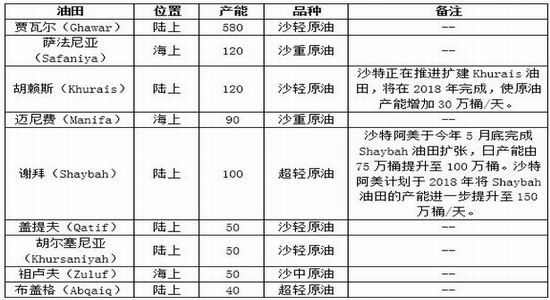
Source: Zhuo Chuang Information, Western Futures
The above-mentioned oilfield has a total production capacity of 12 million barrels per day. From January to October this year, Saudi Arabia's daily average crude oil production was 10.35 million barrels. Based on this calculation, Saudi Arabia's current crude oil production capacity is 1.65 million barrels per day. According to the Saudi government's existing plan, by 2018, the Hurais and Sabai oil fields will increase their production capacity by 800,000 barrels per day. Therefore, in the case of Saudi Arabia, it is expected that by 2018, with the existing
The completion of the oilfield capacity expansion plan will further increase the Saudi crude oil production capacity to 12.8 million barrels per day. Although some mature oil fields in Saudi Arabia are inevitably faced with the natural decline in production, according to the Saudi Ministry of Petroleum and Mineral Resources, the decline rate of production in mature oil fields in the country is not more than 2%, based on current production, that is, the annual production decline rate is not More than 20 barrels / day. Taking into account the rate of production decline, Saudi crude oil production capacity will remain at 12.4 million barrels per day by 2018. Even if Saudi crude oil increased production to 11 million barrels per day, and the Russian production is equally divided, its crude oil surplus capacity will remain at a high level of 1.4 million barrels per day.
2. Iran
Before Europe and the United States imposed comprehensive economic sanctions on Iran, Iran was OPEC's second largest oil producer. However, due to years of European and American sanctions, a large number of oil companies suspended exploration and investment in Iran, and Iranian crude oil exports were once even sealed, resulting in a decline in crude oil production in the country. However, with the lifting of sanctions against Iran in early 2016, the country’s crude oil output ushered in an explosive period and production increased rapidly. As of October 2016, Iran produced an average of 3.69 million barrels of oil per day, which is equivalent to the 3.7 million barrels per day before the 2011 European and American sanctions.
Although Iranian crude oil production has returned to pre-sanction levels, the pace of crude oil production in the country has not stopped. Due to the previous joint sanctions in Europe and the United States, the Iranian oil industry was hit hard. Western oil companies have suspended production in the oilfield block, and external investment has been cut sharply, and lack of experience and technology has hindered further growth of crude oil production in the country. However, this year the Iranian government intends to reform the traditional repurchase contract model, allowing foreign investment companies to participate in more development and production links, and to invest 200 billion US dollars into the oil and gas industry to increase oil and gas production and sales.
The Iranian oil minister said that the country plans to achieve an average daily production of 4.28 million barrels of crude oil and condensate production of 1 million barrels in four years. This is the first time that Iran has set a production target of 5 million barrels per day. In addition, in November this year, Iran has three new oil fields announced to enter the production mode, increasing the country's total crude oil production by 220,000 barrels / day. The three fields are Yadavaran, NorthAzadegan and NorthYaran, which are three of the five oil fields shared by Iran and Iraq. NorthYaran's initial production is estimated at 30,000 barrels per day, North Azadegan production will be 75,000 barrels per day, and Yadavaran is expected to produce 115,000 barrels per day.
In addition to the above three oil fields, the country will have about 400,000 to 650,000 barrels per day of crude oil production coming into the market by 2020.
As for whether Iran’s future crude oil production capacity can be further improved, there is still a big variable. Will Trump continue to impose sanctions on Iran after it takes office. Once the US restarts nuclear sanctions against Iran after 2017, the country's crude oil production capacity is expected to be re-compressed, and there is a risk of a sharp decline in crude oil output.
Table 2: Summary of the date of production of Iranian oilfield projects (unit: thousand barrels / day)
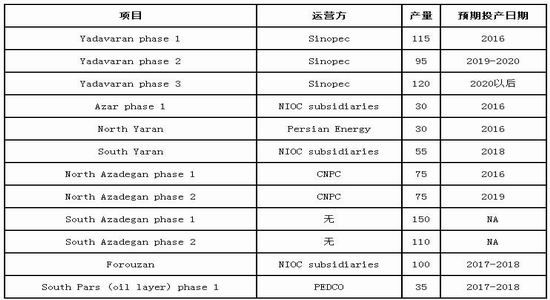
Source: Zhuo Chuang Information, Western Futures
3. Iraq
Iraq is currently OPEC's second-largest oil producer. Although the country has suffered from wars for many years, crude oil production is still growing steadily. According to the OPEC monthly report, from January to October 2016, Iraq’s crude oil output was about 4.33 million barrels per day, an increase of 500,000 barrels per day compared with the same period last year. Nearly 90% of the country's crude oil production comes from the southern region, and the remaining 10% is produced in the northern region. Since June 2015, the country has divided Basra crude oil into two varieties, light and heavy. Prior to the differentiation, heavy crude oil production was limited to ensure the quality of Basra light oil. After distinguishing the quality, the production of heavy crude oil in Basra has increased significantly. At the same time, the quality of Basra light oil has been further guaranteed.
During the period 2008-2009, the Iraqi government twice publicly tendered to develop the country's oil fields and increase crude oil production. However, because of the persistently low international oil prices in recent years, the country has experienced an economic crisis and, coupled with ISIS, its crude oil production target has been significantly reduced. At the beginning of the year, the tender for the country's crude oil production is expected to increase to 12 million barrels per day by 2017. Subsequently, the statement is revised and the production target is adjusted to increase to 9 million barrels per day by 2020, and then the target is further reduced to 6 million. Barrel / day. Moreover, the Iraqi oil minister recently confirmed again that by 2020 Iraq will raise its oil production capacity to 6 million barrels per day. Therefore, from the current plan, by 2020, Iraq will have more than 1.5 million barrels per day.
Oil production capacity is yet to be released.
4. Libya
According to the latest data released by BP, as of the end of 2015, Libya has 6.3 billion barrels of crude oil reserves and a storage-production ratio of 306.8 years, making it the largest crude oil storage country in Africa.
Libya was once one of the largest oil producers in Africa, after Nigeria and Angola. Before the Libya civil war in 2011, the country's crude oil production was about 1.6 million barrels per day. However, after the fall of the Qaddafi regime, the situation in the country was in chaos and crude oil production plummeted. Although crude oil production in the country once recovered to 1.4 million barrels per day in 2012, in mid-2013, due to the strike of domestic oil workers and the shutdown of the port, crude oil production fell sharply again, and has remained at 400,000 for a long time. Barrel/day level.
As the country is currently caught in the situation of the separation of the two governments, and the eastern militants have long blocked the operation of the oil port, a large number of production capacity has been interrupted. The Libyan national army, led by General Khalifa Hafter, controlled the country's major oil fields, including Sarir, Zala, Marada and Ghani, while its western ally Zintan tribe controlled the Wafa oil field, which produced 300,000 barrels.
Although in July this year, the country's two oil companies reached an agreement, will be merged into a national oil company, and unified management. However, because the military armed forces that control the oil fields and ports have not participated in the agreement, some oil fields in the country will still be shut down, and the normal exports of some ports will also face long-term troubles.
However, even so, Libyan National Oil Company is still trying to increase production, and the end of the year production target is 900,000 barrels / day. At present, Libya's crude oil production has risen to 600,000 barrels per day, and Libya is expected to be exempted from the frozen production agreement reached by OPEC. The increase in crude oil production will not be interfered by external forces. Therefore, as long as the Libyan government approves the budget plan of the National Oil Company, it is confident that Libyan crude oil production will be further pushed up. Libyan National Oil Company President Sanalla said Libya's oil production will rise to 900,000 barrels per day by the end of 2016 and will reach 1.1 million barrels per day by 2017. At present, the Libyan National Oil Company is trying to restart the two fields of Al-Sharara and Al-Feel in the southwest through legal and political channels, with a total output of 450,000 barrels per day.
Figure 1: Libyan crude oil production

Figure 2: Libyan crude tea energy distribution
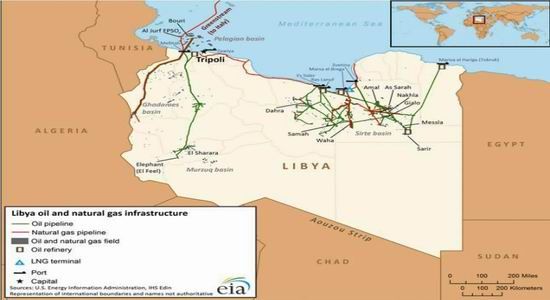
Source: WIND, Western Futures
5. Nigeria
Nigeria was once the largest oil producer in Africa. In 2005, the country's crude oil production reached a peak of 2.44 million barrels per day. But then, due to the influence of domestic militants, multinational oil companies withdrew a large number of employees and suspended crude oil production, resulting in a continuous decline in production.
In 2015, Nigeria produced 1.9 million barrels of crude oil per day. However, after 2016, the armed attacks on the Nigerian Delta militants have escalated and the crude oil exports of the Forcados oil export terminal and the Okan oil platform have been suspended. In May of this year, after Shell closed a major oil pipeline, the country's crude oil production is expected to fall to the lowest in more than 20 years. The closure of the port and the attack on the oil pipeline led to a sharp drop in crude oil production in the country, which was once the lowest level in 20 years. Coupled with the sharp drop in international oil prices, Nigeria, the largest economy in Africa, has suffered a huge impact. According to data collected by Bloomberg, Nigeria was once the largest oil producer in Africa, but now it has been surpassed by Angola and relegated to second place.
However, with the gradual stabilization of the domestic situation in Nigeria, the country’s crude oil production has gradually recovered from a low point. In addition, similar to Libya, although OPEC reached a preliminary consensus on production cuts at the end of September, considering the economic situation in Nigeria, the country will also enjoy the right to cut production. Moreover, the country’s oil minister recently stated that OPEC has allowed the country to appropriately increase crude oil production to 2.2 million barrels per day on the basis of the current 1.8 million barrels per day, and this increase is expected to be reached before the end of the year.
In addition, in the next two years, the country will have three onshore oil and gas block projects in progress, and it is expected that there will be a total of 250,000 barrels per day of new output in 2017-2018. Due to the uncertainty of the country's supervision, the project in the deepwater area was postponed again, and the production date of the project will be close to 900,000 barrels per day after 2020.
Table 3: Date of commissioning of Nigerian oilfield project (unit: thousand barrels/day)
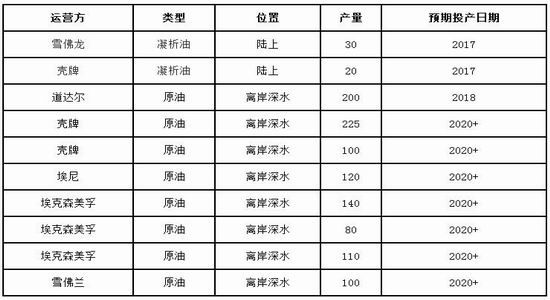
Source: Zhuo Chuang Information, Western Futures
In addition to the above five OPEC members, the output levels of the remaining member states are relatively limited and the remaining capacity is relatively small.
However, in the next few years, the remaining capacity of Venezuela is expected to increase significantly. The Orinoco heavy oil belt in the north of the country is extremely rich in crude oil reserves. Once the situation in the country is stable and the international oil price is gradually improved, the country is bound to greatly increase the investment and development of the oil field.
V. Summary
Figure 3: OPEC Remaining Capacity
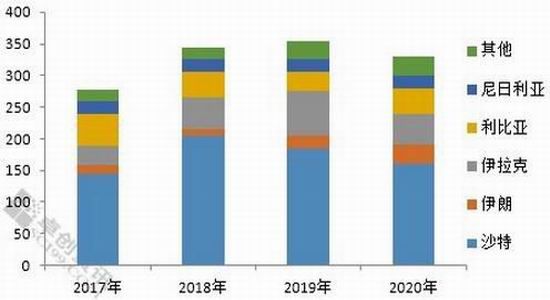
Source: Zhuo Chuang Information, Western Futures
In summary, in 2017-2020, with the further expansion of the Saudi oilfield capacity, the Iranian and Iraqi governments have formulated and adopted new oil production contracts, and the situation in Libya and Nigeria has gradually stabilized. It is expected that OPEC will have a surplus of about 2.5-3.5 million. Barrel/day of crude oil surplus capacity, and this will also provide a strong guarantee for OPEC to consolidate its global oil market share for a long time. In addition to OPEC, the United States currently reserves thousands of stock wells, Kazakhstan Kasak glycerin field project restarts, future capacity is expected to further increase. After Trump took office, the acceleration of the Keystone XL pipeline project will further stimulate the release of crude oil capacity in western Canada. Therefore, from this perspective, the future global oil production capacity is extremely sufficient. We do not believe that global oil supply and demand will quickly return to equilibrium. In other words, international oil prices will also fluctuate at low and medium levels for a long time.
Even if short-term OPEC member countries cut production, but the market share will be driven by the interests of the market, the pattern of limited production will soon be broken, so the rebalancing of global supply and demand pattern must rely on demand growth and supply improvement under the market economy to complete, short-term It is difficult to change the long-term pattern only from the intervention of the supply side. The impact on oil prices is limited to short-term psychological expectations, causing market volatility. Considering that the current global supply and demand pattern is gradually improving, the medium and long-term oil prices of crude oil may show a strong range of fluctuations, US crude oil. The index runs at $45-53; the oil index runs at $47-55.
Western Futures Zhou Meili
Sina statement: Sina's posting of this article for the purpose of transmitting more information does not mean agreeing with its views or confirming its description. Article content is for reference only and does not constitute investment advice. Investors operate on this basis at their own risk.Nantong NATASHA Textiles Co.,Ltd. , https://www.ntnatashatextile.com